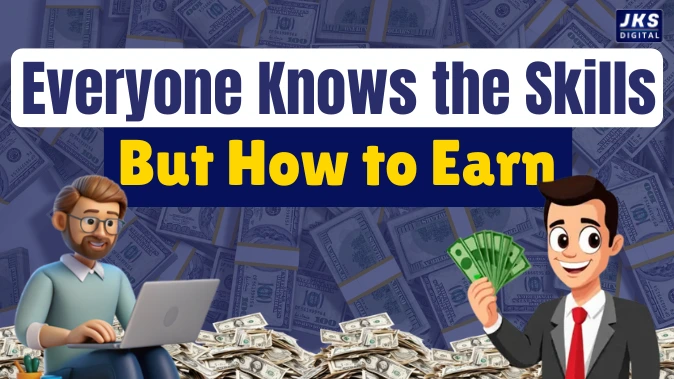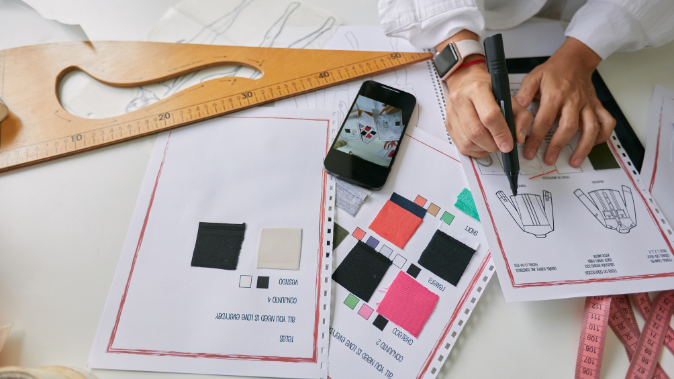How to Earn Money from Top Skills:- In today’s digital age, learning new skills has become easier than ever. YouTube tutorials, online courses, and social media are flooded with content on “Top Skills to Learn in 2025.” Most people know what these skills are — digital marketing, video editing, graphic design, content writing, etc. But knowing a skill and earning from it — these two things are completely different.

This article is not just another skill list. It is a practical guide that will take you step-by-step — from learning to earning.
Why This Guide Is for You
You might wonder — do I really need a guide to start earning from my skill?
If you fall under any of the categories below, the answer is: Yes.
- You are a student who wants to support yourself or gain experience.
- You are a job seeker who keeps applying but is not getting results.
- You are a freelancer who doesn’t know how to get clients or grow.
- You are a homemaker who wants to build an income stream from home.
- You are a professional thinking about a career switch.
- You are an entrepreneur who wants to bring their business online.
This guide is written for all of you — not just theory, but real, actionable steps. And that’s exactly what you’ll find here. You are definitely going to learn something from this guide, so it is very important for you — read it completely.
Step 1: Choose the Right Skill for You

The biggest mistake beginners make — choosing a skill just because it is trending.
That rarely works in the long run. Instead, ask yourself:
- What do I naturally enjoy doing?
- Am I good with visuals, words, or numbers?
- Do I enjoy working with people or behind the scenes?
- Can I stay consistent with it for the next 6–12 months?
Based on these points, choose a skill that fits you. It’s important to learn a skill you’re genuinely interested in. If you go only for trending skills, you might never become an expert in them. Below are some popular options — if you are interested in any of these, you can choose one. Otherwise, choose according to your preference:
- Digital Marketing – For those who like strategy, creativity, and online growth.
- Content Writing – For those who enjoy storytelling, blogging, or research.
- Graphic Design – For creative visual minds.
- Video Editing – For those who love visuals, timing, and cinematic touch.
- Web Development – For logical and detail-oriented thinkers.
- Social Media Management – For those who understand trends and are always online.
Step 2: Learn the Skill — But with Purpose

Just watching videos or getting lost in tutorials is useless. Take a focused approach:
- Start with free resources – YouTube, blogs, and free courses will help you build the base.
- Move towards structured learning – Invest in a paid course (Udemy, Coursera, or a mentor-led program).
- Practice while learning – Don’t wait till the course ends. Start with small projects. If you don’t practice, you may forget what you learned.
- Build your portfolio – Create samples or case studies, even if you have to work for free at the beginning. If you do some work for free in the beginning, it will benefit you later — so think long-term.
Your goal here isn’t just to learn — but to become so good that you can solve real problems.
Step 3: How to Find Real Earning Opportunities

Now comes the most asked question — how to start earning?
Here are some tried and tested ways:
1. Freelancing Platforms
Start with small gigs on Fiverr, Upwork, Freelancer, or Toptal.
- Write a strong bio, clearly explain your services. Include the free work you’ve done for others.
- Keep initial prices competitive.
- Stay professional in communication and delivery. Your first client opens the door to your future.
2. Cold Outreach
Make a list of businesses that might need your services.
- Send a clear, personalized message with how you can help and a portfolio link.
- Small businesses need good and trustworthy people — which could be you.
3. Build a Personal Brand
Use LinkedIn, Instagram, or YouTube to showcase your expertise.
- Share what you’re learning, how you work.
- Over time, people will start approaching you on their own.
4. Offer Local Services
Provide your service to shops, coaching centers, etc. in your area.
- They often need websites, marketing, or branding — but don’t know where to start.
So, explain clearly how it will benefit them. Highlight the benefits — if you highlight benefits, people will be attracted to get work done.
Step 4: Improve, Grow, and Repeat
Once you get a few projects or clients, the real work begins.
- Take feedback and improve.
- Build systems – templates, communication methods, and workflows that save time.
- Keep investing in learning – learn new skills, learn how to scale your income.
- Network – join communities where people share work, experience, and learning.
Growth happens when you consistently deliver and keep learning along the way.
Some Common Mistakes to Avoid

- Waiting for perfection – Just start. You’ll improve with time. It takes time to grow online, but hard work wins.
- Undervaluing your work – Don’t always charge too low. Increase your price as your value grows. Start low only at the beginning, then increase your value.
- Jumping on every skill – Focus on one skill enough to get results.
- Being afraid to promote yourself – You don’t need to become an influencer, but people should know what you do.
Knowing a top skill is just the first step. Real success is when you turn that skill into a service, product, or brand.
And for that, you don’t need to be a genius — just clarity, consistency, and courage.
Whether you’re just starting or already skilled, the roadmap is the same:
Learn → Practice → Build a Portfolio → Promote Yourself → Earn → Grow
And remember — thousands are already doing this.
You can too.
Not tomorrow, not next week — start today.
Step 1: You Learned the Skill, But How to Practice?

Here comes the point about practice — because
“Learning without Practice = Zero Output”
Action Plan:
- Start with Free Resources
YouTube, blogs, free PDFs — but don’t just passively learn. - Invest in a Paid Course (₹500–₹3000)
Learn in a structured way from Udemy, Skillshare, Learnyst, or a trusted trainer. - Create Your Own Practice Projects
Whatever skill you learned, don’t just talk about it — show it.
Make a small project or sample that gives a glimpse of your work to the client and helps them understand what you can really do.
Step 3: Build a Portfolio That Speaks Louder Than Words

What is a Portfolio?
Practical proof of your work — so that a client looks at it and says, “Yes, I want this person.”
How to Build:
| Step | What to Do | Tools |
|---|---|---|
| 1 | Create 3 to 5 Sample Projects | Canva, WordPress, Google Docs |
| 2 | Show in Case Study Format | What was the goal → What you did → Result |
| 3 | Create a Folder on Google Drive | Make a Shareable Link |
| 4 | Make a Free Portfolio Website | Carrd.co, Wix, Notion |
Pro Tip:
Using free tools like Canva or Notion, you can build an impressive portfolio — no coding, no cost.
Understand this: Portfolio is the voice that presents your business’s identity and capability to the world.
Step 4: 4 Real Ways to Earn

- Freelancing Platforms
- Fiverr, Upwork, Freelancer
- Starting charges: ₹500–₹1500 per task
- Consistency + client handling skills are essential
- Cold Email / DM Outreach
- DM local businesses or Instagram creators
- Tell them what you can create for them
- Offer 1 Free Sample as a bonus (builds trust)
- Leads via LinkedIn and Instagram
- Keep sharing your work
- Clients start approaching you
- Real branding starts from here
- Teaching / Coaching
- Teach what you’ve learned to others
- Start earning through YouTube or paid sessions
Time Required (Realistic Estimate)
| Phase | Approximate Time |
|---|---|
| Learning the Skill | 1–3 months (2–3 hours daily) |
| Practicing | 1–2 months |
| Preparing Portfolio | 1 week |
| Getting First Client | 1–2 months (with right strategy) |
| Earning ₹10,000 | 3–6 months (with full-time focus) |
Top Tips Used by Experts (Made Simple)

- “Charge Less, Deliver More”
Start with low charges, but give more value — this builds your identity. - “Position Yourself as a Solution”
Don’t sell skills, sell solutions. Tell the client,
“I will save your time” or
“I will increase your revenue” — that’s it! - “Learn, Earn, Upgrade”
Learn something new every month, and also learn how to sell it. - “Document Everything”
Show glimpses of your work on platforms like Instagram and LinkedIn — many people are silently observing you.
Your consistency and skills can influence many silent observers. - “1 Hour Rule”
Give just 1 hour daily to practice — you’ll see massive difference in 3 months.
Bonus: A Winning Portfolio Template (Format)
[Intro Section]
Hi, I’m [Your Name], a [Skill] specialist helping brands/creators/businesses achieve [Result].
[Work Samples]
- Project 1 – Goal, What I did, Outcome
- Project 2 – Goal, What I did, Outcome
- Project 3 – Goal, What I did, Outcome
[Testimonials (if any)]
Even one client review adds trust.
[Contact]
Email / Instagram / LinkedIn Link
Read Also:- T-Shape Marketing: The Hidden Power of Digital Leaders
Conclusion: You Just Need to Start
If you have a skill, you have a way to earn — the difference lies in mindset and system.
Your hard work and consistency are what matter.
Everyone faces problems in the beginning — we did too, you might too.
So just keep going, the result will speak for itself.
“Done is better than perfect.”
Effort done every day, little by little, can turn into income in a few months.
Those who have made it big in freelancing today also started with a simple portfolio and ₹500 projects on Fiverr.
Every expert was once a beginner — the only difference is that they started and kept learning.
Now it’s your turn.





